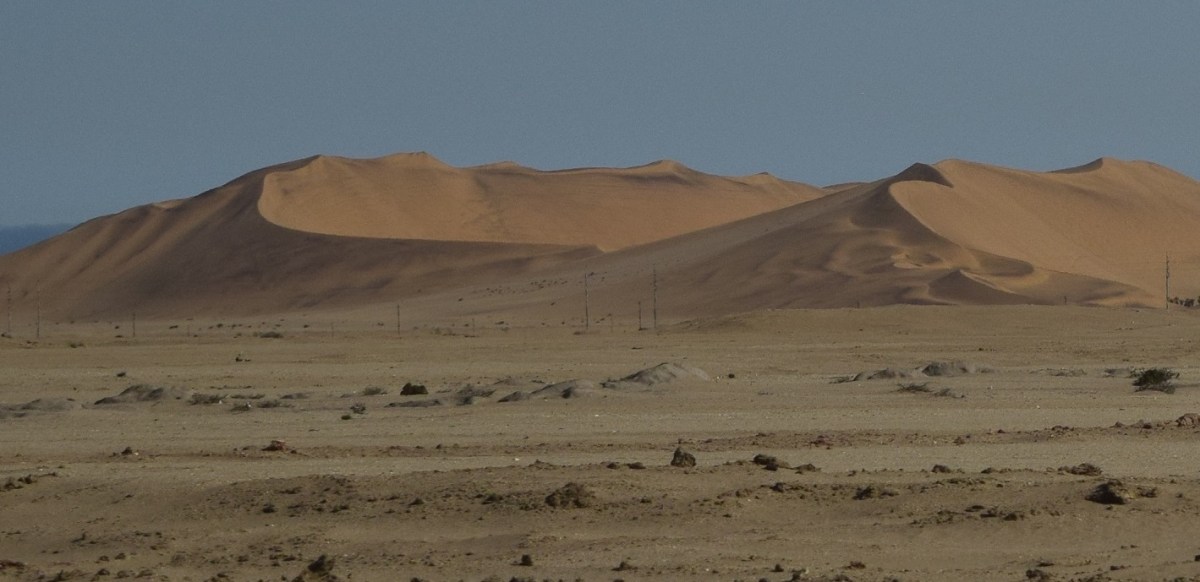by Ellen Gray / WALVIS BAY, NAMIBIA /
This desert was nothing like what I expected. Flying in to Walvis Bay Airport in Namibia, Africa, unbroken beige stretched as far as I could see out the window, lined with the occasional road and dotted by the occasional black rock outcrop, like islands in the sea.
From the ground at first glance, it’s pretty boring in most directions: big sky and flat sand with little to interrupt the horizon. Until you turn and see what look like orange-ish mountains in the distance. They’re not mountains. They’re dunes. As we drive closer, they keep getting bigger. The Crocodile Dundee voice in my head says “Now, that’s a dune.”

The dunes are the most spectacular feature of the Namib Desert, one of the oldest deserts in the world, that runs the length of the Namibian coast on the western shore of Africa. But it’s the coast – specifically the clouds above the Atlantic Ocean to the west – that have brought a team of NASA and university scientists and two research aircraft to this remote region for a NASA airborne mission: Observation of Aerosols above Clouds and their Interactions (ORACLES).
Offshore are two things that make the coast of Namibia unique in the entire world: a layer of low-lying cumulus clouds and above that a steady layer of smoke particles – a type of aerosol – that are borne westward on the winds from forest and brush fires over central Africa.

Aerosols and how they change the behavior of clouds are one of the biggest mysteries in the climate change puzzle. Do aerosols make clouds thicker? Do they reflect more sunlight, or change how much sunlight clouds reflect? Do they absorb sunlight and make the atmosphere warmer? The lessons learned from flying above and through this “perfect natural laboratory,” as principal investigator Jens Redemann put it, will yield insights into cloud-aerosol interactions around the world.
The same conditions that make the low-lying clouds also make the coast really foggy in the morning. The fog is a reliable source of moisture for the plants that cover rocks and boulders sticking out of the sand. Desert-warmed air condenses over cold ocean water to form a marine layer, similar to the ones seen on the California coast.

We are staying in Swakopmund, a tourist town about 45 minutes from the more industrial city of Walvis Bay. This is a former German colony town founded in 1892, and you can see the influence on the architecture. The town is built out rather than up. A constant breeze blows keeping the late August air a nice 70 to 75 degrees Fahrenheit.
As we drive south toward the airport on our first full day here, we’re between two extremes with the Atlantic ocean out the right window and the desert out the left.

The ocean is blue and huge, and vacation rentals dominate a long section of beach, giving way to a view of offshore drilling platforms in the distance as we near the city of Walvis Bay. Like Swakopmund, the city is spread out, and signs on the highway caution to watch out for children crossing between two residential areas.

At the southern reach of the city new construction is going up as we turn inland toward the desert and the airport. The dunes in the distance grow until we pass Dune 7, the tallest in the area at over 1200 feet. Out here, under the sun, the temperature will be in the 90s F by midday.
Soon after we arrive at Walvis Bay Airport, a tiny bump on the horizon that will be the ORACLES base of operations for the next month. A spill of scientists, freshly badged for airport access, disembark out of the shuttle van, ready to go.


